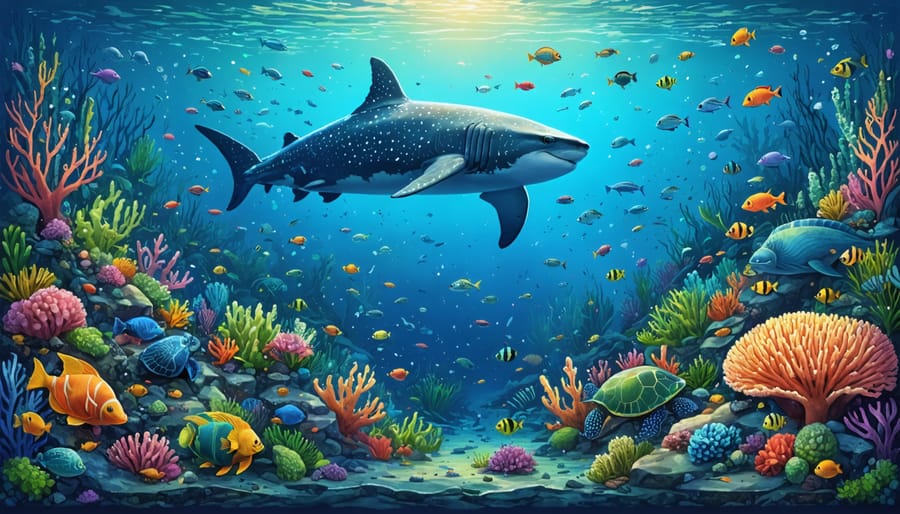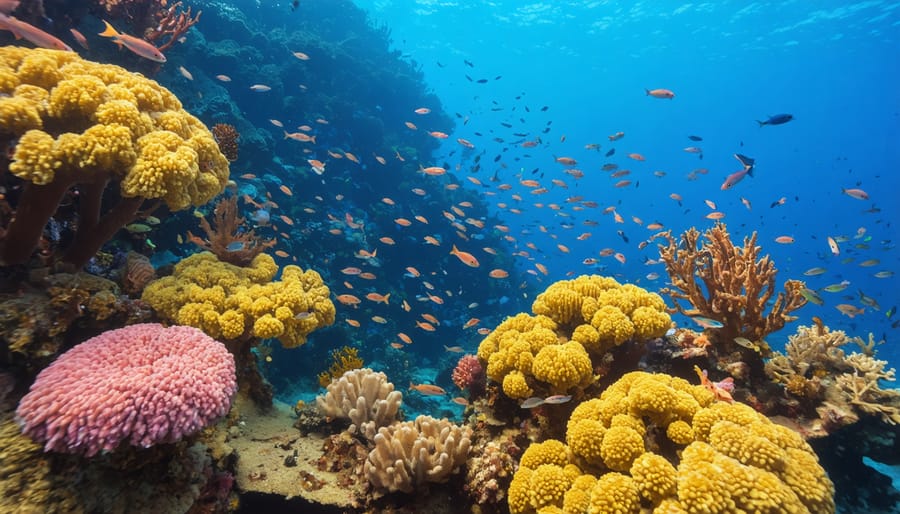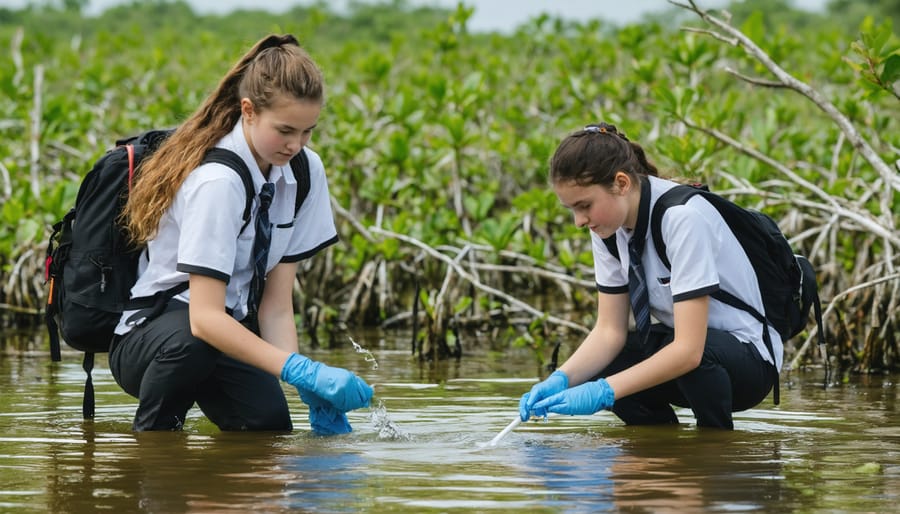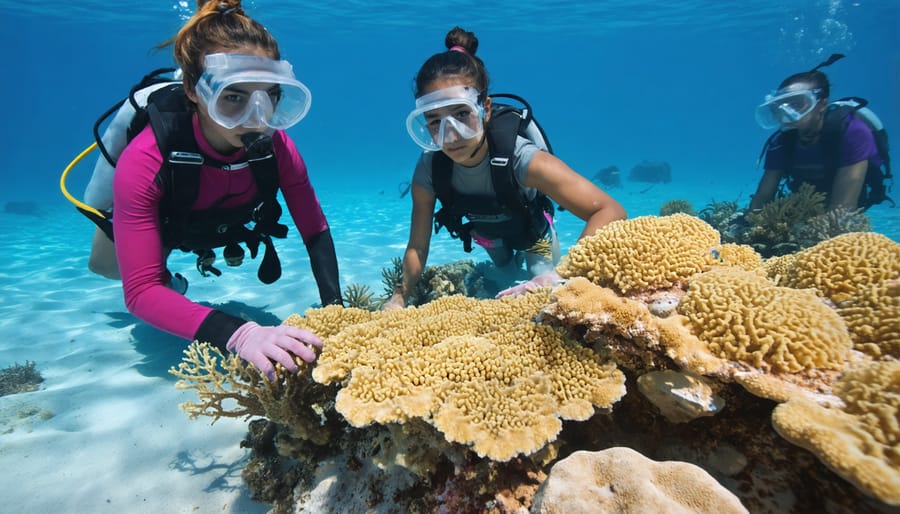
Dive into the vibrant world of tropical marine ecosystems, where coral reefs, seagrass meadows, and mangrove forests create an interconnected web of life supporting over 25% of all marine species. These underwater paradises, stretching across Earth’s equatorial waters, represent nature’s most spectacular demonstration of biodiversity and ecological interdependence. From the microscopic phytoplankton that produce half of our planet’s oxygen to the majestic whale sharks that migrate through these warm waters, every organism plays a crucial role in maintaining the delicate balance of these marine communities. Yet these extraordinary ecosystems face unprecedented challenges from climate change, ocean acidification, and human activities, making their conservation not just an environmental imperative but a race against time to preserve one of Earth’s most valuable natural treasures. Understanding these complex marine environments is essential for developing effective conservation strategies and ensuring their survival for future generations.
The Building Blocks of Tropical Marine Ecosystems
Coral Reefs: Nature’s Living Classrooms
Coral reef ecosystems serve as remarkable natural laboratories, offering unparalleled opportunities for hands-on learning and scientific discovery. These vibrant underwater communities provide educators and students with living examples of ecological concepts, from symbiotic relationships to food web dynamics.
Marine biologists and educators frequently utilize coral reefs to demonstrate complex biological principles in action. Students can observe the intricate relationships between cleaner wrasses and their client fish, witness the dramatic color changes of octopi, or study the architectural precision of coral polyps building their calcium carbonate homes.
These underwater classrooms also offer powerful lessons in conservation biology. By monitoring reef health over time, students gain practical experience in scientific methodology while developing a deep appreciation for marine conservation. Many educational programs now incorporate virtual reality and underwater cameras, allowing learners to explore reef environments without physical presence.
Local communities near reef systems have developed innovative educational programs that combine traditional ecological knowledge with modern scientific understanding. These programs often feature citizen science initiatives, where students and community members contribute to real-world research by collecting data on coral health, fish populations, and water quality.
The educational value of coral reefs extends beyond marine biology, incorporating elements of chemistry, physics, and environmental science, making them ideal settings for interdisciplinary learning and inspiring the next generation of marine conservationists.

Mangrove Forests: Coastal Learning Laboratories
Mangrove forests serve as remarkable natural laboratories for understanding coastal ecosystems and their interconnections. These unique environments, where land meets sea, provide invaluable opportunities for hands-on learning about biodiversity, ecological processes, and environmental adaptation.
Students and researchers studying mangrove ecosystems can observe complex root systems that not only stabilize coastlines but also create nursery habitats for countless marine species. The distinct zonation patterns of mangrove species demonstrate clear examples of environmental adaptation, while the diverse wildlife – from mud crabs to wading birds – offers insights into food web dynamics and species interdependence.
These coastal forests also provide excellent case studies for understanding climate change impacts and adaptation strategies. By monitoring water quality, sediment accumulation, and carbon sequestration within mangrove ecosystems, researchers can gather crucial data about environmental changes and their effects on coastal communities.
Educational programs in mangrove forests often incorporate citizen science initiatives, allowing students to participate in real research projects. Activities might include measuring tree growth rates, conducting wildlife surveys, or analyzing water quality parameters. This hands-on experience not only enhances learning but also contributes to long-term monitoring efforts.
The accessibility of mangrove forests to coastal communities makes them ideal venues for public education about marine conservation. Through guided walks, interactive workshops, and restoration projects, these ecosystems continue to serve as living classrooms for environmental education.
Hands-On Learning in Tropical Waters
Field Study Techniques
Conducting research in tropical marine ecosystems requires specialized field study techniques that balance scientific rigor with environmental sensitivity. Researchers typically employ non-invasive observation methods, including underwater photography, video transects, and quadrat sampling to minimize ecosystem disturbance while collecting valuable data.
Snorkeling and SCUBA diving serve as primary tools for direct observation, allowing researchers to conduct visual census of marine species and document behavioral patterns. These activities require proper certification and adherence to safety protocols, particularly when working in deeper waters or around sensitive coral formations.
Water quality testing is another crucial component, involving the collection of samples to measure parameters such as salinity, temperature, pH levels, and dissolved oxygen. Portable testing kits and data loggers enable researchers to gather real-time information about environmental conditions affecting marine life.
For studying marine organisms, catch-and-release techniques using specialized nets or traps are employed when necessary, always prioritizing the wellbeing of the specimens. Researchers often utilize GPS tracking and mapping tools to record species distributions and movement patterns across the ecosystem.
Modern technology has enhanced traditional methods through the use of underwater drones, acoustic monitoring devices, and satellite imaging. These tools provide comprehensive data about ecosystem health and species interactions while minimizing human impact on sensitive marine environments.
Citizen science programs have become increasingly valuable, allowing volunteers to contribute to data collection efforts while learning about marine conservation. This collaborative approach not only expands research capabilities but also helps build public awareness and support for marine ecosystem protection.

Technology in Marine Education
Modern technology has revolutionized how we learn about and interact with tropical marine ecosystems. Virtual reality (VR) systems now allow students to take immersive virtual dives through coral reefs, providing safe and accessible exploration opportunities for those who might never experience these environments firsthand. These virtual experiences help learners understand complex ecological relationships and marine species behaviors in their natural habitats.
Underwater cameras and live streaming technologies enable real-time observation of marine life, connecting classrooms directly to reef environments. Students can watch coral spawning events, witness predator-prey interactions, and observe daily patterns of marine species, creating engaging learning experiences that bring textbook concepts to life.
Mobile applications and citizen science platforms have transformed data collection and monitoring efforts. Students and educators can contribute to marine research by recording species sightings, monitoring coral health, and tracking environmental changes using their smartphones. This hands-on involvement not only enhances learning but also contributes valuable data to conservation efforts.
Geographic Information Systems (GIS) and satellite mapping tools help visualize and analyze marine ecosystem changes over time. These technologies enable students to understand the impact of climate change, pollution, and human activities on tropical marine environments through clear, data-driven visualizations.
Remote sensing technologies and underwater drones provide unprecedented access to deeper marine environments, allowing educators to showcase previously inaccessible ecosystems. These tools capture high-resolution imagery and collect environmental data, helping students understand the interconnectedness of marine ecosystems across different depths and regions.
Online learning platforms and interactive educational resources make marine education accessible to a global audience, fostering international collaboration and knowledge sharing among students, educators, and marine scientists.
Conservation Through Education
Student Engagement in Research
Student engagement in marine research has proven to be a powerful tool for both conservation efforts and educational development. Through hands-on experience in tropical marine ecosystems, students gain invaluable practical skills while contributing to vital research projects. Many universities and research stations now offer programs where students can participate in coral reef monitoring, sea turtle conservation, and mangrove restoration initiatives.
These engagement opportunities often begin with basic training in scientific diving, species identification, and data collection methodologies. Students learn to conduct underwater surveys, measure coral growth rates, and monitor fish populations. This practical experience is complemented by data analysis and research documentation skills, preparing them for future careers in marine science.
Notable success stories include student-led projects that have contributed to the discovery of new species and the implementation of local conservation measures. For instance, undergraduate researchers in the Indo-Pacific region have helped identify previously unknown coral species and documented the effects of climate change on reef systems.
The benefits extend beyond scientific discovery. Students develop a deep personal connection to marine ecosystems, often becoming passionate advocates for ocean conservation. Many program alumni go on to pursue careers in marine biology, environmental policy, or conservation education, creating a ripple effect of positive impact on tropical marine ecosystem protection.
These programs also foster international collaboration, with students from different countries working together on shared conservation goals. This cultural exchange enriches the learning experience and builds a global network of future marine conservation leaders.
Community-Based Learning Programs
Engaging local communities in marine education has proven to be one of the most effective ways to protect tropical marine ecosystems. Through community-based learning programs, residents become active participants in conservation efforts while gaining valuable knowledge about their marine environment.
These programs typically involve partnerships between marine scientists, local schools, and community organizations. Activities range from guided reef walks and snorkeling expeditions to citizen science projects where community members help collect data on coral health and marine species populations. Local fishermen often serve as knowledge holders, sharing traditional ecological wisdom with younger generations while learning about sustainable fishing practices.
The success of these initiatives lies in their ability to create personal connections between people and their marine environment. When local communities understand the direct link between healthy marine ecosystems and their livelihoods, they become powerful advocates for conservation. Programs often include hands-on activities like mangrove restoration, beach cleanups, and coral reef monitoring, giving participants practical experience in marine conservation.
Many communities have established marine education centers that serve as hubs for learning and community engagement. These centers often feature interactive exhibits, touch tanks, and educational materials in local languages, making marine science accessible to everyone from schoolchildren to elderly community members.

Success Stories from the Field
The Marine Conservation Education Program in Raja Ampat, Indonesia, stands as a shining example of successful tropical marine ecosystem education. Since its inception in 2015, the program has trained over 200 local youth as coral reef ambassadors, leading to a 60% increase in community participation in reef protection initiatives.
In the Philippines, the Coral Triangle Initiative’s “Sea Rangers” program demonstrates how combining traditional knowledge with modern conservation techniques can yield remarkable results. Local fishermen-turned-educators now lead marine biology workshops for students, sharing their extensive knowledge of reef ecosystems while incorporating scientific monitoring methods. This program has successfully educated more than 5,000 students and contributed to a 40% reduction in destructive fishing practices in protected areas.
The Great Barrier Reef’s “Reef Guardians Schools” program showcases the power of early environmental education. This initiative connects over 300 schools with marine scientists, allowing students to participate in real-world conservation projects. One particularly successful project involved students from Cairns State High School, who developed an innovative method for monitoring coral bleaching using underwater photography, which is now being adopted by other schools across the region.
In the Caribbean, the “Blue Ambassadors” program has transformed how local communities interact with their marine environment. Through this initiative, former tour operators have become certified marine educators, leading educational snorkeling tours that combine tourism with conservation awareness. The program has reached over 10,000 visitors and locals, resulting in the establishment of three new community-managed marine protected areas.
The Maldives’ “Coral Doctors” program represents another success story, where local youth are trained in coral restoration techniques. These young conservationists have successfully transplanted over 6,000 coral fragments and educated their communities about reef conservation. Their work has led to a measurable increase in fish populations and improved coral cover in restored areas.
These success stories share common elements: community involvement, hands-on learning experiences, and the integration of scientific knowledge with local expertise. They demonstrate that effective marine ecosystem education not only increases environmental awareness but also leads to tangible conservation outcomes and sustainable community development.
Tropical marine ecosystems stand as remarkable testaments to nature’s complexity and beauty, offering invaluable lessons in biodiversity, interconnectedness, and environmental stewardship. Through understanding these vibrant underwater communities, we gain crucial insights into global ocean health and climate change impacts. The future of these ecosystems depends on informed, dedicated individuals taking action through education, conservation, and community engagement. Whether you’re a student, educator, or concerned citizen, there are numerous ways to get involved – from joining local marine conservation projects to supporting research initiatives or pursuing marine biology education. By sharing knowledge about tropical marine ecosystems and actively participating in their preservation, we can help ensure these precious underwater worlds continue to thrive for generations to come. The time to act is now, as our oceans face unprecedented challenges that require collective effort and dedication to overcome.
jessica
Ava Singh is an environmental writer and marine sustainability advocate with a deep commitment to protecting the world's oceans and coastal communities. With a background in environmental policy and a passion for storytelling, Ava brings complex topics to life through clear, engaging content that educates and empowers readers. At the Marine Biodiversity & Sustainability Learning Center, Ava focuses on sharing impactful stories about community engagement, policy innovations, and conservation strategies. Her writing bridges the gap between science and the public, encouraging people to take part in preserving marine biodiversity. When she’s not writing, Ava collaborates with local initiatives to promote eco-conscious living and sustainable development, ensuring her work makes a difference both on the page and in the real world.
